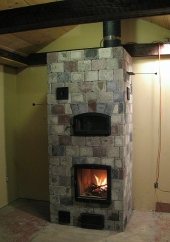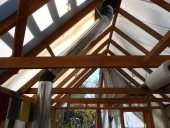posted 11 years ago
Been reading all I can for a while. We are in process of renovating a home we just purchased. Pretty excited due to the prospect of being able to have a wood burning something. Planning on putting a RMH in our basement as a place to hang out around, read books, and gather when friends come over in the winter. Plans are pretty much "by the book". Fire brick stove, 55 gallon drum, insulated riser, cob mass bench, and feeding that into the existing centrally located chimney. Chimney is pretty normal at probably 30 feet ish. Planning on putting the J style burn box and barrel near what used to be the exterior wall made from cinder block as an added mass for heat absorption. That will feed into a bench of about 8 to 10 feet long and then exit into the chimney. Fire brick will be sourced from a local refractory (45 minutes) supplier for the main feed, chamber, and riser (price is about $2.50 per brick, 2700 degree brick). Have a friend who is an excavator and says he hits clay all the time and can give me all I need and then some. I have no idea the quality of the clay, but it's free clay and a good starting point for my mass. I am currently building a "proof of concept"flue size in our back yard out of regular masonry brick that was demo'd from inside our house (gas fireplace surround) just to see if I get the idea of building the guts.
Current questions are:
Would an 8' truck bed of clay be enough for the whole mass?
Can the guts be built well using clay slip instead of mortar? (Donkey on that forum stated just dipping each brick into clay slip during the build)
I think my flue size entrance to the chimney is only around 8", so would 8" flue in the mass be sufficient or should I use something like 10" and neck it down to 8" right before the chimney.
I have taken university physics a year ago so the concepts of the laws are still somewhat fresh. (Changed my world BTW)
FULL DISCLAIMER: I am aware of basement RMH being frowned upon. It's the best I can do. It won't be for whole home heating and not really supplemental heating, but more so heating to keep it toasty warm in the winter months.








